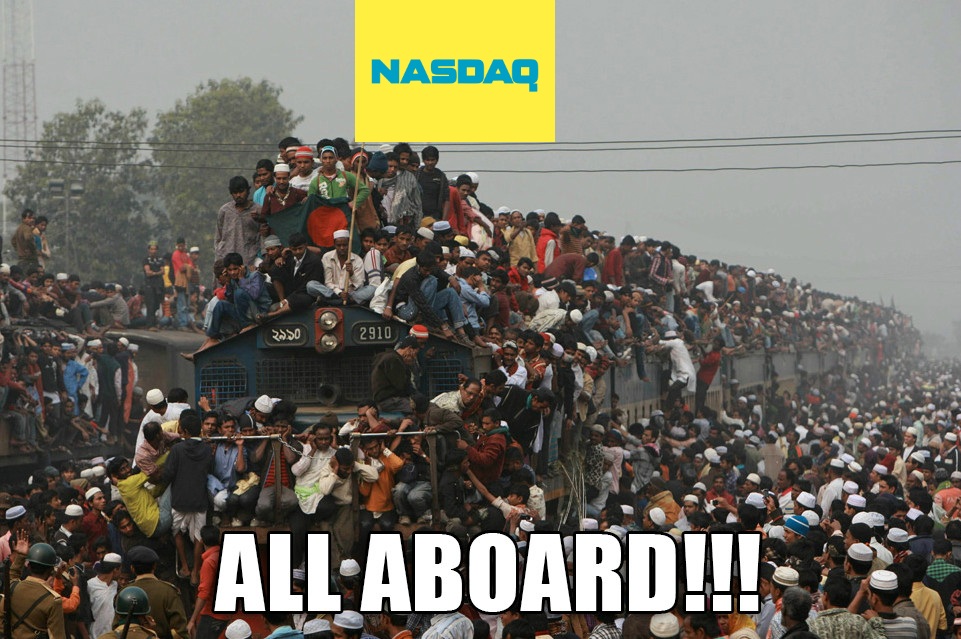
6/20/2018 – A mixed day with the Dow Jones down 42 points (-0.17%) and the Nasdaq up 56 points (+0.72%)
Are you scratching your head wondering why the Nasdaq/Russell 2000 are surging higher while the Dow is negative for the year? And no, it has nothing to do with Trump’s trade war.
The secret has to do with identifying exact patterns and time/price targets for all indices involved. That is exactly what we talked about in our daily update today. If you would like to find out exactly what the stock market will do next, based on our timing and mathematical work, please Click Here.
In the meantime, here is yet another massive red flag to consider. 
We couldn’t add very much to this article from ZeroHedge.com
Active Managers Go ‘All-In’ Again As “Growth/Value Bubble Looks Ominously Similar To Late 1999”
Despite trade wars, central bank tightening, declining economic fundamental data, and an Emerging Market crisis, according to one survey, active US investment managers are presently more than 100% invested, on average.
However, while US equities continue to charge ahead, alarm bells elsewhere are ringing very loud…
Judging by the reaction in China, you would’ve thought global markets were in for a thrashing after President Donald Trump’s latest escalations on trade.

However, as Bloomberg notes, the question of why American equities keep skating past a worsening trade conflagration has been baffling for strategists.
“We’ve had more negative catalysts and more negative pull this year than we’ve had for a long time, but the positives continue to prevail in the investor’s mind,” Jeff Carbone, a managing partner at Cornerstone Wealth in North Carolina, said by phone.
“They’re shrugging off the negativity and taking the positive to a greater extent that this is not the end.”
As Bloomberg notes, the ignorance of risk is everywhere: Equity funds are only a trifle less long than at the height of January’s euphoria.
It’s in markets for call options, where individual investors are engaged in a buying binge of historic dimensions.

It’s in tech stocks (favored by short sellers), and ones with shaky balance sheets, all of which recently surged…

On the back of an historic short-squeeze…

In credit markets, various indicators are flashing bright red. For instance Bank Loans have been pummeled the last few days…
“The scary thing is that everyone keeps warning about leverage but then keeps reaching for the yield that BBB provides,” said Andrew Forsyth, a portfolio manager with BNP Paribas Asset Management.

Emerging Markets have been a bloodbath in recent weeks…

With 42 straight days without inflows for the biggest EM ETF…

It’s not like people haven’t been warned. They have their memories of February and March, and strategists at banks like Morgan Stanley and Goldman Sachs have repeatedly urged investors to rein in optimism, citing everything from politics to peak earnings and monetary tightening. Earlier today, Citigroup Inc. flagged a potential bubble in growth stocks.
“This is fine for now, but we think by year end such a ‘risk on’ hierarchy will be misplaced given the more uncertain outlook posed by ‘peaky’ growth rates and ever tightening financial conditions,” Mike Wilson, chief U.S. equity strategist at Morgan Stanley wrote in a note to clients Monday.
He urged investors to go defensive in anticipation of a rotation out of companies whose growth is tied to economic growth and upgraded utility stocks.
But the caveats have gone unheeded.
Wilson isn’t alone among analysts who see trouble brewing. As Bloomberg reports, the rally in growth stocks brought flashbacks of the internet bubble to Citigroup strategists led by Robert Buckland, even as valuation premiums are less than half of those from almost two decades ago.

A collapse would bode ill for a market whose gains have been increasingly anchored on tech giants such as Amazon.com Inc. and Facebook Inc.
“Price action of the U.S. growth/value trade looks ominously similar to late 1999,” the strategists wrote.
“Watch out for a growth bubble.”
With the price of call options now trading above their historic average, investors should sell them to reap extra returns in a market whose upside appears limited with valuations stretched, according to Rocky Fishman, an options strategist at Goldman Sachs. The firm predicted the S&P 500 will end next year at 3,000, or an 8 percent increase from the last close. That’d be below the 45th percentile in the index’s history over any 18-month period.
“The potential for upside surprises in U.S. equities is lower than the compensation received from elevated call prices,” he wrote in a note.
Coincidentally or not, such indications of retail euphoria flared up in January, just before the S&P 500’s first 10 percent correction in two years. It also accompanied the bull market peaks in 2000 and 2007.

